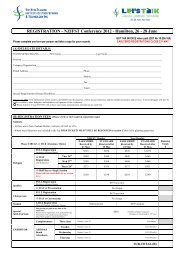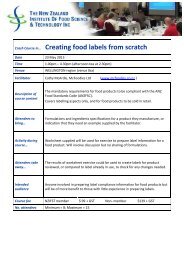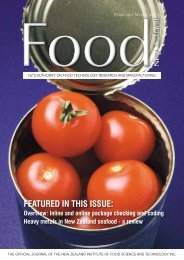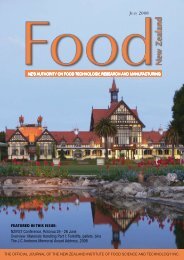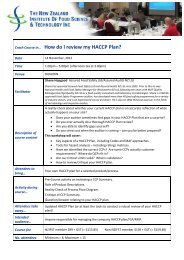featured in this issue - NZIFST - The New Zealand Institute of Food ...
featured in this issue - NZIFST - The New Zealand Institute of Food ...
featured in this issue - NZIFST - The New Zealand Institute of Food ...
You also want an ePaper? Increase the reach of your titles
YUMPU automatically turns print PDFs into web optimized ePapers that Google loves.
PROTEOS – the future <strong>of</strong><br />
world prote<strong>in</strong><br />
<strong>The</strong> PROTEOS programme is an important collaboration<br />
between the Riddet <strong>Institute</strong> and Wagen<strong>in</strong>gen University,<br />
launched <strong>in</strong> October <strong>in</strong> the Netherlands by our M<strong>in</strong>ister<br />
<strong>of</strong> Agriculture, the Hon. David Carter (1).<br />
At the launch, Mr Carter had <strong>this</strong> to say:<br />
“PROTEOS is aimed at solv<strong>in</strong>g global prote<strong>in</strong> shortages. As<br />
we all know, the world faces a grow<strong>in</strong>g food crisis, with the<br />
global population expected to top n<strong>in</strong>e billion by 2050. <strong>The</strong><br />
demand for animal prote<strong>in</strong> by then will be twice what we are<br />
capable <strong>of</strong> produc<strong>in</strong>g now. Our capacity to meet <strong>this</strong> demand<br />
<strong>in</strong> a susta<strong>in</strong>able manner will be a huge challenge.”<br />
<strong>The</strong> FAO, <strong>in</strong> their report World agriculture: towards<br />
2030/2050 suggests that the demand for livestock products,<br />
pr<strong>in</strong>cipally meat and dairy, could double by 2050, driven by<br />
population growth and by economic development enabl<strong>in</strong>g<br />
improved diet <strong>in</strong> develop<strong>in</strong>g countries (2). It is generally<br />
recognised that production <strong>of</strong> animal-derived foods requires<br />
more land resources than plant-based foods, although estimates<br />
vary from 1.3 times to 10 times or more (3). Given<br />
the limitations <strong>of</strong> agricultural resources (pr<strong>in</strong>cipally land and<br />
water) and susta<strong>in</strong>ability considerations (greenhouse gases<br />
and energy use), a large <strong>in</strong>crease <strong>in</strong> productivity and susta<strong>in</strong>ability<br />
is called for.<br />
<strong>The</strong> PROTEOS programme aims to contribute by enabl<strong>in</strong>g<br />
novel solutions that <strong>in</strong>volve substitut<strong>in</strong>g and extend<strong>in</strong>g future<br />
animal-based prote<strong>in</strong> sources, thus facilitat<strong>in</strong>g a transformation<br />
<strong>of</strong> the prote<strong>in</strong> supply cha<strong>in</strong> <strong>in</strong> an economical and<br />
susta<strong>in</strong>able manner. <strong>The</strong> programme will address a range<br />
<strong>of</strong> solutions <strong>in</strong> the context <strong>of</strong> technical, social, cultural and<br />
economic feasibility. PROTEOS <strong>in</strong>tends to develop an array<br />
<strong>of</strong> <strong>in</strong>itiatives that will allow susta<strong>in</strong>able systems <strong>of</strong> animal<br />
production to meet future needs, such as through rais<strong>in</strong>g efficiency<br />
by <strong>in</strong>creas<strong>in</strong>g the production <strong>of</strong> high-quality prote<strong>in</strong><br />
per unit <strong>in</strong>put, and develop<strong>in</strong>g suitable replacement prote<strong>in</strong>s.<br />
Such solutions will need to be matched to the scale<br />
<strong>of</strong> projected market opportunities as well as to regional and<br />
local needs, particularly <strong>in</strong> develop<strong>in</strong>g economies.<br />
<strong>The</strong> PROTEOS team <strong>in</strong>volves scientists from Massey University<br />
and other Riddet partners and the University <strong>of</strong> Wagen<strong>in</strong>gen,<br />
from a wide range <strong>of</strong> discipl<strong>in</strong>es work<strong>in</strong>g together.<br />
Areas <strong>of</strong> expertise <strong>in</strong>clude food science and eng<strong>in</strong>eer<strong>in</strong>g, nutrition<br />
(animal as well as human), economics and consumer<br />
studies.<br />
PROTEOS will achieve its aim through a number <strong>of</strong> <strong>in</strong>tegrated<br />
approaches. A comprehensive mapp<strong>in</strong>g <strong>of</strong> the problem<br />
and potential solutions will first be undertaken, <strong>in</strong>clud<strong>in</strong>g<br />
mapp<strong>in</strong>g the technological, socio-economic and geopolitical<br />
landscapes. This will allow the identification relevant work<br />
that has already been completed and assessment <strong>of</strong> the viability<br />
and impact <strong>of</strong> potential solutions.<br />
Possible partial solutions that are to be considered <strong>in</strong>clude<br />
(but are not limited to):<br />
• use <strong>of</strong> novel sources <strong>of</strong> prote<strong>in</strong>s (e.g. from <strong>in</strong>sects or<br />
algae – particularly for animal feed),<br />
• use <strong>of</strong> lower <strong>in</strong>put prote<strong>in</strong>s as extenders for high value<br />
animal prote<strong>in</strong>s,<br />
• use <strong>of</strong> plant-based prote<strong>in</strong>s for substitution or extension<br />
<strong>of</strong> animal prote<strong>in</strong>s,<br />
• development <strong>of</strong> niche high-value prote<strong>in</strong> <strong>in</strong>gredients as<br />
nutritional balancers,<br />
• wider use <strong>of</strong> food waste and <strong>of</strong> co-products from nonfood<br />
applications such as bi<strong>of</strong>uels for animal nutrition.<br />
<strong>The</strong> PROTEOS programme has adopted the follow<strong>in</strong>g propositions:<br />
• Future prote<strong>in</strong> demand requires enhanc<strong>in</strong>g the<br />
susta<strong>in</strong>able production <strong>of</strong> prote<strong>in</strong> from all possible<br />
sources.<br />
• Current plant-based prote<strong>in</strong> sources will become<br />
<strong>in</strong>creas<strong>in</strong>gly important <strong>in</strong> future human nutrition while<br />
animal nutrition will rely <strong>in</strong>creas<strong>in</strong>gly on alternative<br />
prote<strong>in</strong> sources.<br />
• Shift<strong>in</strong>g prote<strong>in</strong> sources up the supply cha<strong>in</strong> will be the<br />
primary basis to meet future prote<strong>in</strong> demand.<br />
• Plant-based substitutes or extenders for animal prote<strong>in</strong><br />
foods will require enhancements <strong>of</strong> nutritional, sensory<br />
and textural properties.<br />
• Successful extended and substituted animal foods will<br />
be those that take <strong>in</strong>to account socio-economic needs<br />
and cultural aspects.<br />
• ... and it has to taste good.<br />
References<br />
1. Project Launched to solve global prote<strong>in</strong> shortage. <strong>Food</strong>NZ<br />
December/January 2011 p. 45.<br />
2. Alexandratos N, Bru<strong>in</strong>sma J, Bödeker G, Schmidhuber J,<br />
Broca S, Shetty P & Grazia Ottaviani M. (2006). World agriculture:<br />
towards 2030/2050. United Nations <strong>Food</strong> and Agriculture<br />
Organisation, Rome.<br />
3. Fairlie, S. (2010) “An acre a meal” <strong>in</strong> “Meat, a benign<br />
extravagance” pp 12-34. Chelsea Green Publish<strong>in</strong>g, White<br />
River, Vt, USA.<br />
For further <strong>in</strong>formation contact Dr Mike Boland, Riddet <strong>Institute</strong>, mikeb@xtra.co.nz<br />
April/May 2011<br />
19



